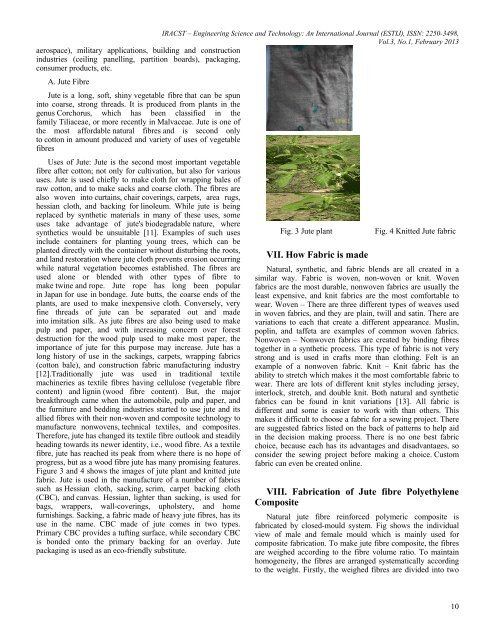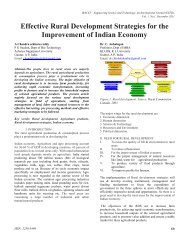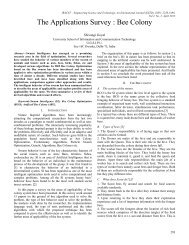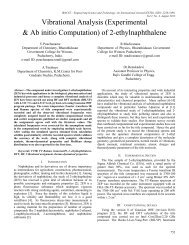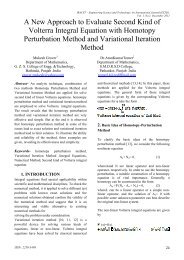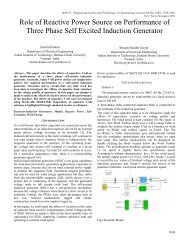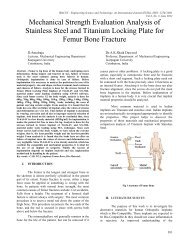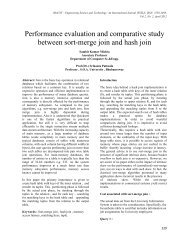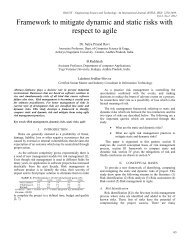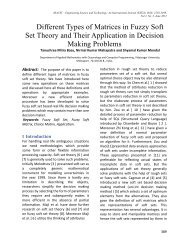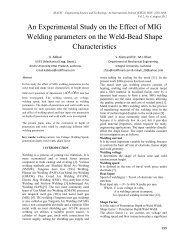testing the vibrational behaviour of jute fiber based sandwich ...
testing the vibrational behaviour of jute fiber based sandwich ...
testing the vibrational behaviour of jute fiber based sandwich ...
Create successful ePaper yourself
Turn your PDF publications into a flip-book with our unique Google optimized e-Paper software.
IRACST – Engineering Science and Technology: An International Journal (ESTIJ), ISSN: 2250-3498,Vol.3, No.1, February 2013aerospace), military applications, building and constructionindustries (ceiling panelling, partition boards), packaging,consumer products, etc.A. Jute FibreJute is a long, s<strong>of</strong>t, shiny vegetable fibre that can be spuninto coarse, strong threads. It is produced from plants in <strong>the</strong>genus Corchorus, which has been classified in <strong>the</strong>family Tiliaceae, or more recently in Malvaceae. Jute is one <strong>of</strong><strong>the</strong> most affordable natural fibres and is second onlyto cotton in amount produced and variety <strong>of</strong> uses <strong>of</strong> vegetablefibresUses <strong>of</strong> Jute: Jute is <strong>the</strong> second most important vegetablefibre after cotton; not only for cultivation, but also for varioususes. Jute is used chiefly to make cloth for wrapping bales <strong>of</strong>raw cotton, and to make sacks and coarse cloth. The fibres arealso woven into curtains, chair coverings, carpets, area rugs,hessian cloth, and backing for linoleum. While <strong>jute</strong> is beingreplaced by syn<strong>the</strong>tic materials in many <strong>of</strong> <strong>the</strong>se uses, someuses take advantage <strong>of</strong> <strong>jute</strong>'s biodegradable nature, wheresyn<strong>the</strong>tics would be unsuitable [11]. Examples <strong>of</strong> such usesinclude containers for planting young trees, which can beplanted directly with <strong>the</strong> container without disturbing <strong>the</strong> roots,and land restoration where <strong>jute</strong> cloth prevents erosion occurringwhile natural vegetation becomes established. The fibres areused alone or blended with o<strong>the</strong>r types <strong>of</strong> fibre tomake twine and rope. Jute rope has long been popularin Japan for use in bondage. Jute butts, <strong>the</strong> coarse ends <strong>of</strong> <strong>the</strong>plants, are used to make inexpensive cloth. Conversely, veryfine threads <strong>of</strong> <strong>jute</strong> can be separated out and madeinto imitation silk. As <strong>jute</strong> fibres are also being used to makepulp and paper, and with increasing concern over forestdestruction for <strong>the</strong> wood pulp used to make most paper, <strong>the</strong>importance <strong>of</strong> <strong>jute</strong> for this purpose may increase. Jute has along history <strong>of</strong> use in <strong>the</strong> sackings, carpets, wrapping fabrics(cotton bale), and construction fabric manufacturing industry[12].Traditionally <strong>jute</strong> was used in traditional textilemachineries as textile fibres having cellulose (vegetable fibrecontent) and lignin (wood fibre content). But, <strong>the</strong> majorbreakthrough came when <strong>the</strong> automobile, pulp and paper, and<strong>the</strong> furniture and bedding industries started to use <strong>jute</strong> and itsallied fibres with <strong>the</strong>ir non-woven and composite technology tomanufacture nonwovens, technical textiles, and composites.Therefore, <strong>jute</strong> has changed its textile fibre outlook and steadilyheading towards its newer identity, i.e., wood fibre. As a textilefibre, <strong>jute</strong> has reached its peak from where <strong>the</strong>re is no hope <strong>of</strong>progress, but as a wood fibre <strong>jute</strong> has many promising features.Figure 3 and 4 shows <strong>the</strong> images <strong>of</strong> <strong>jute</strong> plant and knitted <strong>jute</strong>fabric. Jute is used in <strong>the</strong> manufacture <strong>of</strong> a number <strong>of</strong> fabricssuch as Hessian cloth, sacking, scrim, carpet backing cloth(CBC), and canvas. Hessian, lighter than sacking, is used forbags, wrappers, wall-coverings, upholstery, and homefurnishings. Sacking, a fabric made <strong>of</strong> heavy <strong>jute</strong> fibres, has itsuse in <strong>the</strong> name. CBC made <strong>of</strong> <strong>jute</strong> comes in two types.Primary CBC provides a tufting surface, while secondary CBCis bonded onto <strong>the</strong> primary backing for an overlay. Jutepackaging is used as an eco-friendly substitute.Fig. 3 Jute plantVII. How Fabric is madeFig. 4 Knitted Jute fabricNatural, syn<strong>the</strong>tic, and fabric blends are all created in asimilar way. Fabric is woven, non-woven or knit. Wovenfabrics are <strong>the</strong> most durable, nonwoven fabrics are usually <strong>the</strong>least expensive, and knit fabrics are <strong>the</strong> most comfortable towear. Woven – There are three different types <strong>of</strong> weaves usedin woven fabrics, and <strong>the</strong>y are plain, twill and satin. There arevariations to each that create a different appearance. Muslin,poplin, and taffeta are examples <strong>of</strong> common woven fabrics.Nonwoven – Nonwoven fabrics are created by binding fibrestoge<strong>the</strong>r in a syn<strong>the</strong>tic process. This type <strong>of</strong> fabric is not verystrong and is used in crafts more than clothing. Felt is anexample <strong>of</strong> a nonwoven fabric. Knit – Knit fabric has <strong>the</strong>ability to stretch which makes it <strong>the</strong> most comfortable fabric towear. There are lots <strong>of</strong> different knit styles including jersey,interlock, stretch, and double knit. Both natural and syn<strong>the</strong>ticfabrics can be found in knit variations [13]. All fabric isdifferent and some is easier to work with than o<strong>the</strong>rs. Thismakes it difficult to choose a fabric for a sewing project. Thereare suggested fabrics listed on <strong>the</strong> back <strong>of</strong> patterns to help aidin <strong>the</strong> decision making process. There is no one best fabricchoice, because each has its advantages and disadvantages, soconsider <strong>the</strong> sewing project before making a choice. Customfabric can even be created online.VIII. Fabrication <strong>of</strong> Jute fibre PolyethyleneCompositeNatural <strong>jute</strong> fibre reinforced polymeric composite isfabricated by closed-mould system. Fig shows <strong>the</strong> individualview <strong>of</strong> male and female mould which is mainly used forcomposite fabrication. To make <strong>jute</strong> fibre composite, <strong>the</strong> fibresare weighed according to <strong>the</strong> fibre volume ratio. To maintainhomogeneity, <strong>the</strong> fibres are arranged systematically accordingto <strong>the</strong> weight. Firstly, <strong>the</strong> weighed fibres are divided into two10


